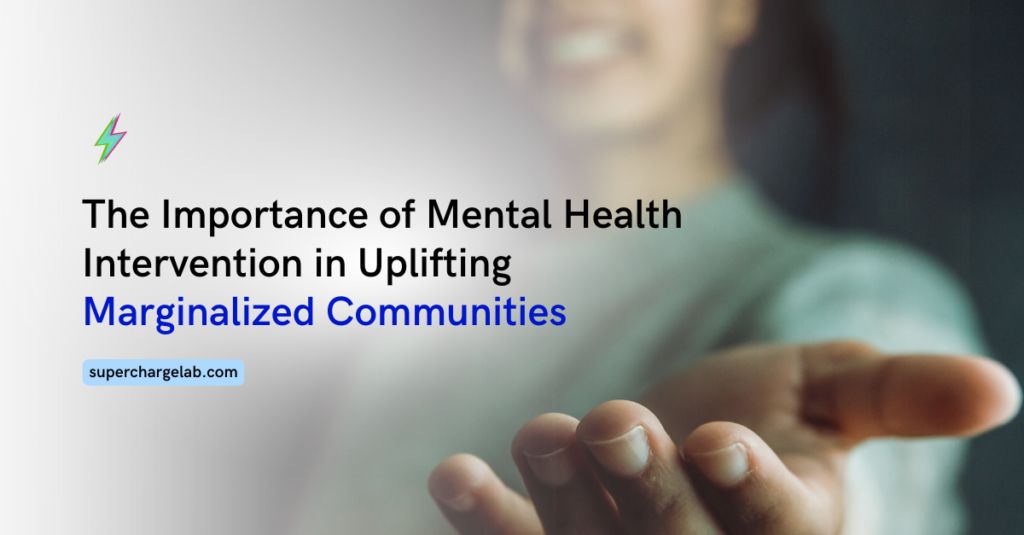
The mental health of marginalized communities is a pressing issue that demands our attention. Individuals facing discrimination, systemic barriers, and historical trauma are disproportionately affected by mental health challenges. It’s time to break the silence and explore how mental health interventions can uplift these communities and create a more equitable society.
1.The Unique Challenges Faced by Marginalized Communities
Marginalized communities, including people of color, LGBTQ+ individuals, indigenous populations, and individuals with disabilities, face unique challenges that can significantly impact their mental well-being. These communities often experience higher rates of discrimination, prejudice, and microaggressions, leading to increased stress, anxiety, and depression. Historical trauma, such as the lingering effects of colonization or systemic oppression, can also contribute to intergenerational trauma and mental health disparities. Moreover, these communities often face systemic barriers to accessing mental health care, such as financial constraints, lack of culturally competent providers, and cultural stigma surrounding mental illness. These challenges can create a cycle of suffering that continues from one generation to the next, making mental health intervention even more critical.
2. Why Mental Health Intervention Matters
In marginalized communities, mental health is not just an individual concern; it’s a key factor in the collective well-being and strength of the community as a whole. Mental health intervention can equip individuals with the tools and support they need to overcome challenges, build resilience, and develop coping mechanisms to manage stress and adversity. By addressing the unique challenges faced by marginalized communities, mental health interventions can:
2.1 Heal Trauma: Provide individuals with tools to process and heal from the effects of historical trauma, reducing the burden of PTSD and complex trauma.
2.2 Build Resilience: Equip individuals with coping mechanisms to manage stress, anxiety, and depression, fostering resilience in the face of ongoing adversity.
2.3 Break Cycles: Interrupt the intergenerational transmission of trauma, paving the way for healthier futures for individuals and their families.
2.4 Empower Communities: Strengthen the collective well-being of marginalized communities, promoting a sense of agency and collective healing.
3. Building a More Supportive System
Building a more supportive mental health system for marginalized communities requires a diverse approach, focusing on several key areas:
3.1 Culturally Competent Training for Professionals:
Equip mental health professionals with the knowledge and skills to understand the unique experiences, and historical contexts of marginalized communities. This empowers them to build trust, dismantle cultural stigma, and provide tailored interventions that truly resonate with their clients.
3.2 Accessible and Affordable Mental Health Programs:
Develop and implement programs that are easily accessible within marginalized communities, removing barriers like cost, transportation, and language. These programs should offer culturally relevant therapy, support groups, and educational resources that address the specific needs and challenges faced by these communities.
3.3 Community-Based Outreach and Education:
Partner with community organizations and leaders to promote open conversations about mental health within marginalized communities. This can involve workshops, awareness campaigns, and culturally appropriate materials that address stigma, encourage help-seeking behavior, and provide information about available resources.
3.4 Representation and Diversity in Mental Health Workforce:
Increase the representation of individuals from marginalized communities within the mental health workforce. This ensures that providers have firsthand experience with the challenges faced by these communities and can offer more culturally sensitive and effective care.
3.5 Policy Advocacy and Systemic Change:
Advocate for policy changes that address systemic inequities and improve access to mental health care for marginalized communities. This may include lobbying for increased funding for mental health services, expanding insurance coverage, and addressing social determinants of health that contribute to mental health disparities.
4. Success Stories and the Power of Community
The path toward mental well-being for marginalized communities is paved with challenges, but it’s not without hope. Innovative solutions are emerging, offering glimpses of a brighter future. One example is the rise of telehealth and community-based mental healthcare during the COVID-19 pandemic. As in-person interactions became restricted, digital care options like tele-therapy and mental health apps exploded in popularity.
These online services have proven invaluable, reaching individuals in remote areas who previously lacked access to care and providing a discreet avenue for those hesitant to seek help due to stigma. By extending the reach of mental health support, telehealth has empowered countless individuals in marginalized communities to prioritize their well-being. Public and private sectors have collaborated to develop online platforms like Togetherall, ReachOut, 7 Cups, and UCLA STAND, often with guidance from community peers. These platforms have become trusted sources of support, information, and referrals, fostering a sense of connection and belonging even in times of isolation.
This success story highlights the power of innovation and community collaboration in addressing mental health disparities. It’s a testament to the resilience and adaptability of marginalized communities, who, even in the face of adversity, have found ways to prioritize their mental well-being and build a more supportive system. We have the opportunity to transform mental healthcare, building on recent progress to make support accessible and equitable for all.
5.Conclusion
Investing in the mental health of marginalized communities is an investment in a brighter future for all. It’s a call to action for individuals, organizations, and policymakers to prioritize mental health resources and support for these communities. By working together, we can break down barriers, create a more equitable and just society, and empower individuals to thrive mentally, emotionally, and physically. Whether through volunteering, donating to mental health organizations, advocating for policy changes, or simply starting conversations about mental health, everyone has a role to play in supporting marginalized communities on their journey to healing and well-being.
Your action, no matter how small, can make a big difference.